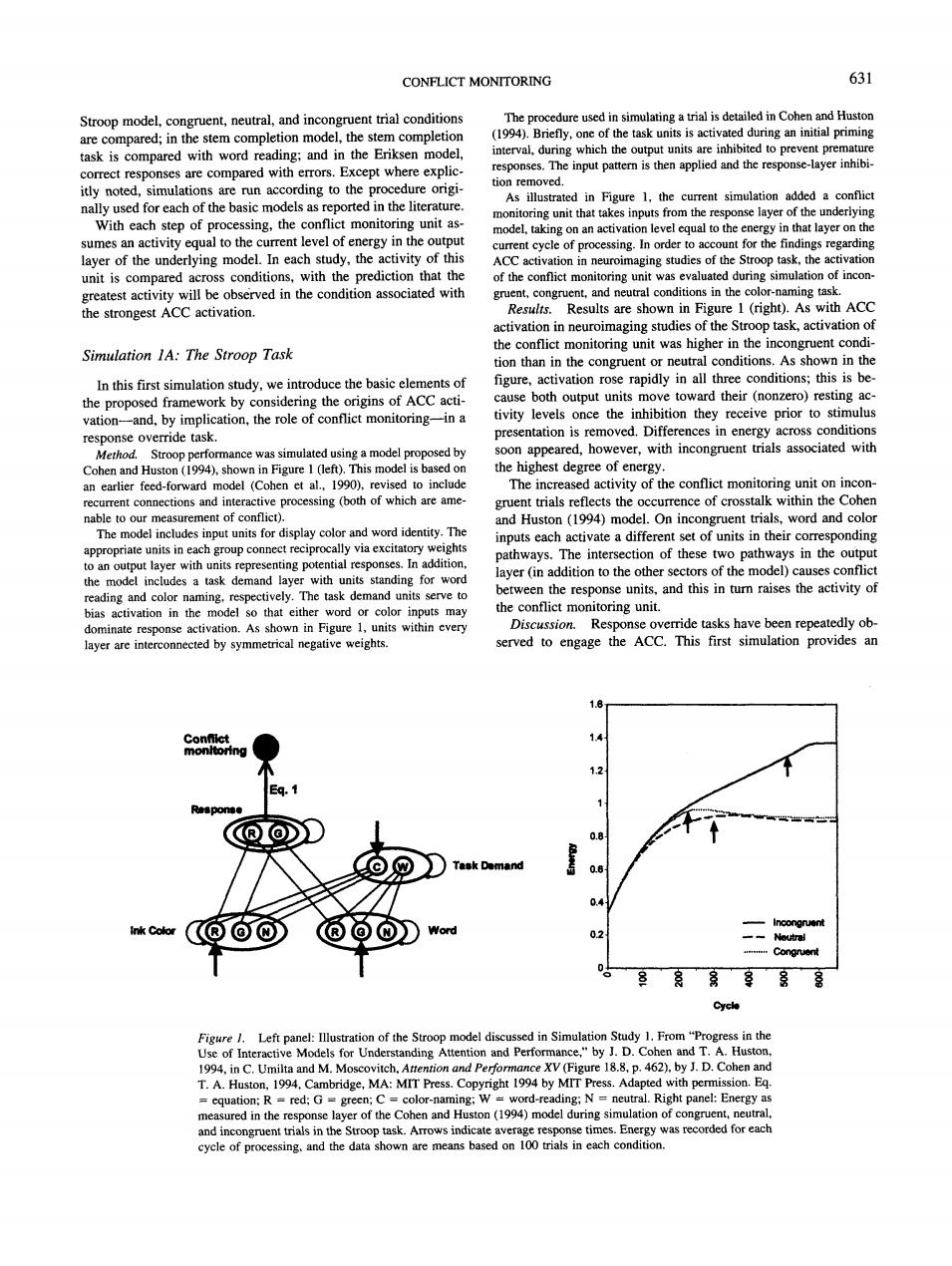正在加载图片...

CONFLICT MONITORING 63 em co letionm nd in rval. mpared ept wh re exp itly not t s n in Figure 1.the current simulation added a ed fo step of pr mon se l ring unit as vation level tudy.the of this ask.the acti the strongest ACC activation. Simulation IA:The Stroop Task the conflic ongruent cond s this is be both output un tow rd thei o)r esting monitoring-in a ntation is rem oss condit mde ta osed b appear ciate are d H he m puts eac its in ea nomeicsaast conflic layer are by symmetrical ved to engage on provides an 12 Q.6 t panel:I o of the Su H 46 T.A. dge,M MIT Press.C RihtpeEneny sured in th En cyele of proce ing.and the data hown are meanCONFLICT MONITORING 631 Stroop model, congruent, neutral, and incongruent trial conditions are compared; in the stem completion model, the stem completion task is compared with word reading; and in the Eriksen model, correct responses are compared with errors. Except where explicitly noted, simulations are run according to the procedure originally used for each of the basic models as reported in the literature. With each step of processing, the conflict monitoring unit assumes an activity equal to the current level of energy in the output layer of the underlying model. In each study, the activity of this unit is compared across conditions, with the prediction that the greatest activity will be observed in the condition associated with the strongest ACC activation. Simulation 1A: The Stroop Task In this first simulation study, we introduce the basic elements of the proposed framework by considering the origins of ACC activation—and, by implication, the role of conflict monitoring—in a response override task. Method. Stroop performance was simulated using a model proposed by Cohen and Huston (1994), shown in Figure 1 (left). This model is based on an earlier feed-forward model (Cohen et al., 1990), revised to include recurrent connections and interactive processing (both of which are amenable to our measurement of conflict). The model includes input units for display color and word identity. The appropriate units in each group connect reciprocally via excitatory weights to an output layer with units representing potential responses. In addition, the model includes a task demand layer with units standing for word reading and color naming, respectively. The task demand units serve to bias activation in the model so that either word or color inputs may dominate response activation. As shown in Figure 1, units within every layer are interconnected by symmetrical negative weights. The procedure used in simulating a trial is detailed in Cohen and Huston (1994). Briefly, one of the task units is activated during an initial priming interval, during which the output units are inhibited to prevent premature responses. The input pattern is then applied and the response-layer inhibition removed. As illustrated in Figure 1, the current simulation added a conflict monitoring unit that takes inputs from the response layer of the underlying model, taking on an activation level equal to the energy in that layer on the current cycle of processing. In order to account for the findings regarding ACC activation in neuroimaging studies of the Stroop task, the activation of the conflict monitoring unit was evaluated during simulation of incongruent, congruent, and neutral conditions in the color-naming task. Results. Results are shown in Figure 1 (right). As with ACC activation in neuroimaging studies of the Stroop task, activation of the conflict monitoring unit was higher in the incongruent condition than in the congruent or neutral conditions. As shown in the figure, activation rose rapidly in all three conditions; this is because both output units move toward their (nonzero) resting activity levels once the inhibition they receive prior to stimulus presentation is removed. Differences in energy across conditions soon appeared, however, with incongruent trials associated with the highest degree of energy. The increased activity of the conflict monitoring unit on incongruent trials reflects the occurrence of crosstalk within the Cohen and Huston (1994) model. On incongruent trials, word and color inputs each activate a different set of units in their corresponding pathways. The intersection of these two pathways in the output layer (in addition to the other sectors of the model) causes conflict between the response units, and this in turn raises the activity of the conflict monitoring unit. Discussion. Response override tasks have been repeatedly observed to engage the ACC. This first simulation provides an Conflict ffitofiftorinQ RMDORM Ink Color Task Dwnand Word 1.6 1.4 1.2 1 0.8 0.6 0.4 0.2 0 Cycte Figure 1. Left panel: Illustration of the Stroop model discussed in Simulation Study 1. From "Progress in the Use of Interactive Models for Understanding Attention and Performance," by J. D. Cohen and T. A. Huston, 1994, in C. Umilta and M. Moscovitch, Attention and Performance XV (Figure 18.8, p. 462), by J. D. Cohen and T. A. Huston, 1994, Cambridge, MA: MIT Press. Copyright 1994 by MIT Press. Adapted with permission. Eq. = equation; R = red; G = green; C = color-naming; W = word-reading; N = neutral. Right panel: Energy as measured in the response layer of the Cohen and Huston (1994) model during simulation of congruent, neutral, and incongruent trials in the Stroop task. Arrows indicate average response times. Energy was recorded for each cycle of processing, and the data shown are means based on 100 trials in each condition